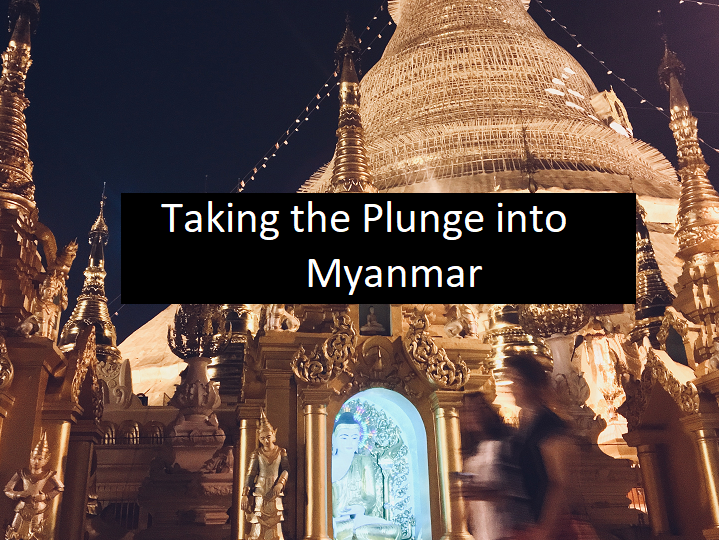Taking the Plunge into Myanmar

Follow my journey, as well as my 2018-19 MBA classmates’ experiences during their time on the Oxford MBA programme, at http://mba.sbsblogs.co.uk/
Roaming the halls during the Oxford Freshers Week in late September, I was floored by the number of societies and student organisations present in the Examination School building. There were what seemed like endless rooms filled with even more societies. And then I haphazardly walked by a booth with the name “Oxford Development Consultancy” written on top that caught my attention. Development consulting had always been an occupation that fascinated me and it was expressly the kind of role I wanted to gain exposure to during my studies in Oxford.

Examination Schools in Oxford, United Kingdom
I moved from interest to action and applied to join one of the eight cycle 1 projects that were listed. I selected VisionFund International in Myanmar as my priority choice and applied as an Assistant Team Leader. During the interview, I was persuaded to take on the responsibilities of Project Leader, and I would cautiously accept the offer. I was so hesitant at first since Oxford’s pace definitely has a way of rapidly filling schedules and over-extending commitments. In theory, I was aware of these realities and decided to prioritise ODC as the flagship experience of my year in Oxford. It was only in the subsequent months that I came to fully understand and appreciate what that would actually mean.
Oxford Development Consultancy Project
Start
On the first evening I was overwhelmed by the flood of responsibilities that I felt as the team leader for a group of 7 student consultants. There is an undenying logic behind the saying of being thrown into the deep end to sink or swim. And a kernel of truth in learning by doing, which I strongly believe in.
So the pressure was on to perform, especially as each member was so immensely talented. The range of ages, cultures, and prior experiences was profound and distinctly Oxonian. I was dealing with one politics, philosophy, and economics (PPE) undergraduate who had co-founded his own debating training organization to a young PPE lady who started a radio show in West Africa, to a high school debate national finalist studying psychology and philosophy, through to several fellow MBA classmates who successfully worked throughout Asia within demanding corporate positions for many more years than me.
It was up to me to create the scaffolding, structures, norms, and culture of the group. Besides the organizational and project aspects, this was the exactly the sort of exercise for why I chose Oxford over standalone business schools: I sought to become involved in the wider university with students from all sorts of disciplines and backgrounds. I wanted to stretch myself and test my leadership abilities to their fullest in an arena that drew me in and that was competitive in nature. It turns out that this project would offer precisely that, and more than I could have imagined.
Client Kick-Off
A few members of the team had donated to World Vision, the umbrella non-profit organization above the microfinance branch of VisionFund International. There was a reputation of good work and robust social impact measurement, so we were keen to interact with such a high-caliber institution. We felt that there was a real opportunity to add value by examining VisionFund’s issues from an outside perspective and to benefit from their expertise and accumulated knowledge in the sector.
The bar was set high for the Oxford brand as was made clear to us from the onset. There was a certain level of expectation associated with the university, and we as a team were up for the challenge. During my previous position, I had been the point of contact with a business school for a mini MBA project, and it was very much kept to the limits of a student assignment. I was determined not to replicate such limitations, by moving beyond such confines for a more professional, and ultimately valuable analysis. The precedent was put in motion.
Middle
As is typical in consulting engagements, we defined the scope of work for the duration of the project. We agreed to an insights sprint deliverable, in-country field visit for observations and recommendations regarding local operations, and a final synthesized report and presentation.
The terms of engagement were to deliver a review of business coaching best practices and an operational review of a new small-growing business (SGB) loan + coaching bundled product. This was after a year-long exercise from the client to pilot a higher value loan that would feature a coaching component for the entrepreneurs themselves. The staff coaches were named Client Relationship Officers (CRO) and we identified that the coaching journey lifecycle was made up of the acquisition, segmentation, business curriculum & coaching, and management stages.
In-Country Visit and Anecdotes
Three of us were able to spend one week during January 17-23, 2019 to conduct semi-structured interviews with over 30 stakeholders, including over 20 clients in the field around Yangon and Hpa-An in Myanmar.

Oxford Development Consultancy Team in Yangon, Myanmar
We were able to directly observe coaching sessions between the CRO and the small-growing business (SGB) customer to detect what behaviours and conversations were most valuable. We had also discerned benchmarks to tease out what were more impactful and less desirable actions.
What we witnessed first-hand was business owners who were shifting their mindset towards employees, customers, partners, suppliers, and other members of their community.
One distinct dialogue that I’ll always remember was with a garment factory owner who expressed that he had a newfound view about the critical importance of his employees to his business success. He now looks for ways to better value and care for them, including providing better accommodation than had previously been provided.

There was another woman who was a group loan microfinance participant of the equivalent of US$ 20 more than 10 years ago. She is now borrowing US$ 6,500, an incredible 300x+ jump in her loan amount! She conveyed her appreciation of being able to buy a car and own land as she runs her daily use retail stores that she was expanding thanks to the small-growing business loans that she had received.

As a whole, it was an exhilarating and humbling week spent listening to small-scale entrepreneurs in Myanmar to learn about the realities surrounding SME growth, financial access, and commercial challenges for low-income communities. Business advisory services coupled to microfinance loans are by no means a panacea to all problems, but the combination can unlock upward mobility potential in the form of jobs, income, and employee welfare in a transitioning economy.

Situational Analysis
The client was introducing a unique product into the market of a higher loan size, with a fairly competitive interest rate, and pairing that with business coaching. The strong word-of-mouth factor (upwards of 2-4 per client) was testament to the belief from clients about the value they derived from this pilot that was reinforced by VisionFund Myanmar’s two decade-long track record. The organisation itself is open to iterating the project design and corporate structure for learning and maximum impact as the staff is highly motivated.

Opportunities that we identified were centered around: aligning entrepreneurial incentives with social impact, using the captive client base of more than 200,000, the rise of digital financial services to reduce frictions, liberalised microfinance regulations, non-Yangon rural areas representing the greatest need, and the potential to expand into agribusiness in rural areas.
Some of the areas of improvement revolved around staff capacity, segmentation of clients, training and support, and a reliance on certain coaching methodologies (business model canvas). There may be other players transitioning into the space for competing products, non-performing loan risks, geopolitics, a risk of oversaturation in the MFI market with 176 players (with the top 10 driving the majority of the market), and currency depreciation and inflationary risks.
Recommendations
We ended with a set of recommendations that drew from the coaching journey of the SGB loan and coaching package. We broadly segmented our findings into the CRO Training, Segmentation and Acquisition, CRO Management, Coaching & Curriculum, and then Additional / Operating Model sections. We sequenced the recommendations into short-term and long-term timeframes.
CRO Training & Support
We essentially wanted to bolster the baseline abilities of the staff and improve support to ensure sustained longevity as the pilot scaled up into a fully-fledged product. Tangible near-term suggestions touched on job shadowing, experiential learning, encouraging specific advice, subsidizing self-learning, introducing sharing sessions/online communication, and building staff capacity in business and IT skills. Longer-term we posited for training duration lengthening, educational resource embedding, retreats and regular reporting, online groups, trainer-of-trainer models, and codifying best practices into documentation.
Segmentation and Acquisition
There is the phrase, “You can’t manage what you can’t measure.” Therefore, we proposed a segmentation strategy for understanding client needs, creating client profiles along different axes, advertising business coaching, continuing word-of-mouth, embedding incentives (networking, classes), reaching out to community leaders, and creating a client referral scheme to boost organic reach.
Longer-term, we submitted conducting quantitative research into behavioral and psychological segmentation, offering improved terms to business coaching completion, and considering reducing guarantor requirements.

CRO Management
How the staff are managed is vital in their performance for the SGB clients. In the early onset, we advised carrying out a needs assessment, providing data entry assistance, and re-allocating marketing tasks to other staff.
On a longer-term basis, we suggested creating a mechanism for continuous feedback and coaching satisfaction, developing coaching-specific metrics, testing CRO workload reductions, including personalities in CRO interviews, increasing openness to external hires, and separating coaches from loan officers to maximize effectiveness of the best coaches.
Coaching & Curriculum
The content of advice supports early wins and client monitoring ensures business uplift down the line. Near-term for teaching clients, our assessment was for making an onboarding package, sharing hard skills, developing a network, and acknowledging CROs as a motivator in their role.
In the future, we put forward reducing guarantor requirements, aligning curriculums with best practices, creating a VIRAL pathway for SGBs modeled on venture capital investment, introducing skills classes, enabling clients to access online resources, and expanding staff motivational skills/flexibility.
Additional / Operating Model
We rounded out our analysis with supplementary issues: re-allocating marketing tasks, tracking client feedback and growth, instilling avenues for feedback, and installing clear points of contacts and escalation pathways.
The last items on the extended time horizon were for client incentives to complete coaching, monitoring of the CRO workload, and for the client continuing along their technology strategy.

Closing
We wrapped up our engagement in the form of a 40+ page report and 2.5-hour presentation. Uniting such a diverse, intelligent team on a voluntary basis was honestly one of the more stringent challenges I’ve had to overcome, but equally one of the more rewarding. Problem-solving is foundational for client cases, although I found it even more important in managing people dynamics. I have come away with a fuller appreciation of the delicate challenges in leadership, especially when coordinating high-potential members. Mistakes are inevitably made although the essential response is to learn and persevere with a blend of internal and external motivations.
To that end, the client made the remark that there was initial reluctance towards hiring a student outfit from Oxford as they were unsure of what could be accomplished and the end-state of deliverables. In concluding, we were told that we had exceeded their original expectations to deliver valuable, actionable, pragmatic, and high-impact recommendations for change.
We were deeply grateful for the access, professionalism, and receptivity that VisionFund collectively offered throughout our interactions remotely and on-the-ground. Most importantly, we felt a sense of responsibility as we were entrusted to carry out our duties with excellence. We were treated with a level of seriousness normally reserved for contracted services, which pushed the team to excel above pre-conceived student standards. We were told that C-level leadership were actively taking our outputs into consideration in their strategy and planning (even during our final conference call), which signals concrete adoption of our findings. While we determined that many features of the SGB loan program were approaching best practice, we hope that our suggestions rooted in pragmatism stand a sound chance for successful implementation in months and years ahead.
Looking back, the idea that we were able to help make the smallest of improvements for the end-beneficiaries — low-income business entrepreneurs and fragile local communities — made the months of labor worthwhile and personally meaningful for all of us. The rare and ideal combination of a substantive project, responsive clients, autonomy, and scope for real impact made the entirety of the challenging engagement extraordinarily enriching. ODC is without a doubt the experience that will mark my year in Oxford, and may very well propel many members of the team, including myself, into new career directions.



